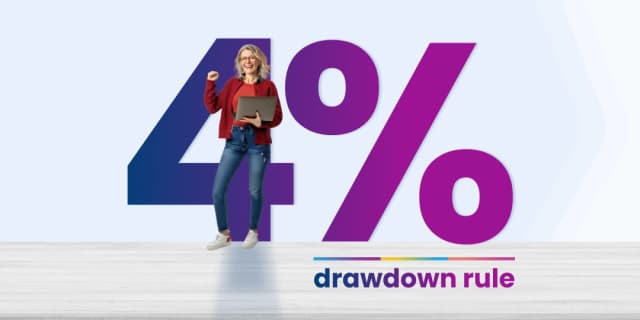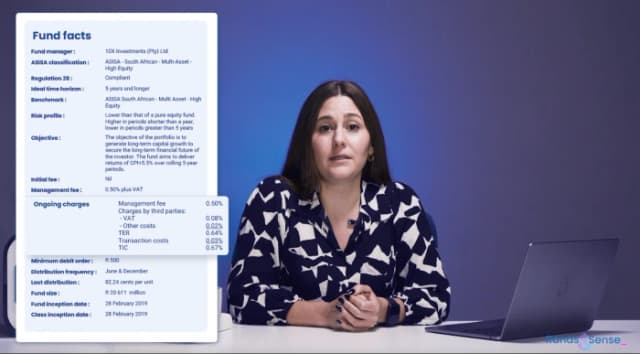Living annuity tax efficiency: Maximising retirement income after taxes
5 December 2024
A living annuity offers retirees the flexibility to manage their retirement savings effectively. With a living annuity, you can choose how your retirement savings are invested and adjust your income withdrawals (between 2.5% and 17.5% of your investment capital), allowing you to adapt your income according to your changing needs throughout retirement. If you'd like comprehensive information on living annuities, and answers to all of the most popular questions we get, check out our Living Annuity FAQ page.

This adaptability enables you to tailor your income based on your goals and life stage, making living annuities a valuable investment product for retirement. Other significant advantages of living annuities is that investment growth within the annuity is not subject to capital gains tax, and you can leave your capital to nominated beneficiaries (which is not the case with a life annuity).
Understanding how living annuities work and what factors to consider can help you make your savings last throughout your retirement. A key consideration is managing costs; fees can significantly impact returns over time, yet they’re often overlooked. Another important consideration is inflation, which can greatly reduce purchasing power over time.
Finally – and this is the focus of this article – you’ll want to consider your drawdown rate. Organising your drawdown rate to stay within lower tax brackets can help you minimise the tax impact on your retirement income. By breaking down and understanding South Africa's tax brackets, you can determine a sustainable, tax-efficient withdrawal structure.
At 10X, we simplify investing by providing all the information you need upfront, without hidden charges, confusing costs, or unreliable call centres. Alongside our calculators and informative resources, our clients have direct access to experienced consultants at no cost, ready to give you all the investment information you need to make informed decisions about your financial future.
Understanding your Living Annuity
A living annuity allows you to invest your retirement savings to generate income while still maintaining growth potential. Your savings are invested in a portfolio of interest-bearing assets, which can generate returns to fund your retirement. When those returns outpace the income you withdraw, inflation, and any associated fees, your investment can continue to grow. Living annuities also offer the flexibility to choose your investment options yourself, adjust income frequency, and customise your withdrawal rate.
The rate at which you withdraw funds from a living annuity (referred to as your drawdown rate) plays a critical role in determining the longevity of your fund. Fees and inflation will also play a part in the equation, and understanding all three will help you set yourself up for a financially stable future and make sure you avoid running out of money in retirement.

Structuring Living Annuity Withdrawals For Tax Efficiency
To ensure you don’t outlive your retirement savings, determining a sustainable drawdown rate is paramount. Traditional wisdom suggests a starting drawdown rate of 4% of the living annuity’s value, and in fact, research done by financial advisor William Bengen supports this view. Adjust that rate for inflation every year, and your money should last 30 years or more.
But there’s more to managing your living annuity than ensuring sustainable withdrawals. Structuring them to ensure their tax-efficiency is another important matter, and requires a healthy understanding of South Africa’s tax brackets. By breaking down and understanding South Africa's tax brackets, you can determine a sustainable, tax-efficient withdrawal structure to maximise your retirement income.
Retirees can benefit significantly from limiting withdrawals to reach lower tax brackets, ultimately minimising the tax impact on their incomes. A lower annual income that stays below a certain threshold has a lower marginal tax rate, preserving more of the take-home amount. If you are able to live on less than what you’re withdrawing, it’s important to consider the tax benefits of adjusting your withdrawals to put yourself in a lower tax bracket.
For example, if your annual income is below R237,100, you fall within the 18% marginal tax bracket for the 2023/2024 tax year. This lower marginal tax rate allows you to retain more of your income compared to higher tax brackets. If your income exceeds this threshold but remains below R370,500, your marginal tax rate increases to 26%, but you still benefit from a relatively lower rate compared to higher income levels.
Living annuities are, however, governed by specific regulations that dictate the permissible annual withdrawal rates of these retirement funds. Legally, you will be expected to withdraw a minimum of 2.5% and can withdraw up to a maximum of 17.5% of the annuity's value each year. If your living annuity provides you with more than you need, and your drawdown rate can’t get any lower, reinvesting is another powerful method of making the most out of your retirement savings and comes with its own tax benefits. By putting the excess funds into a retirement annuity (which is tax-deductible up to a point) your taxable income will again decrease.
Note: The growth within your living annuity is also free of capital gains tax, giving you a significant tax advantage. It allows your savings to grow more efficiently, and enhances your growth potential compared to other investment vehicles. Funds within your retirement annuity can then be transferred into your living annuity.
At 10X Investments, we provide investors with the tools needed to efficiently manage their investments and get the most out of their retirement savings. With our free and easy-to-use living annuity calculator, you can get an estimate of the monthly income you could receive based on a initial capital investment, taking factors like your current age, your retirement goals, and your total savings into consideration.
A Quick Note On Estate Planning And Living Annuity Tax
On top of the flexibility and tax benefits of living annuities, these financial products also offer the benefit of avoiding estate duty – if you have named beneficiaries for the fund. As long as there is capital remaining in your living annuity, it can continue to provide financial benefits to future generations. If your spouse inherits your living annuity after your passing, they can continue to draw an income from it, and any leftover capital after their death can be passed on to the next nominated beneficiary.
However, when you name beneficiaries to leave your living annuity to, the income from the fund might push the dependent into a higher tax bracket. That dependent will then be taxed according to income tax rates on the total amount they earn in any given month.
For example, let’s say John passes away. His spouse, Carol, who is in a lower tax bracket, suddenly starts receiving money from John’s fund as his beneficiary. Carol would then be taxed on her total gross income, which includes her regular salary and whatever she’s drawing from the living annuity. If Carol wishes to minimise her taxable income, she can put the additional money into a retirement annuity so that she can receive the associated tax benefits.
If Carol decided instead to take a lump sum or even a partial lump sum from the fund (as opposed to a continuous income), she will be taxed at the lump sum withdrawal rate which John was initially subject to. However, if John hasn’t utilised his R550,000 tax-free withdrawal, Carol can withdraw up to that amount completely free of tax.
The Golden Equation In Retirement Income Planning
If you haven’t heard of the Golden Equation, it’s a formula retirees can use to make sure they never run out of money. In short, the equation helps you ensure your total costs don’t outweigh the returns you’re earning, and takes inflation into account as one of those costs. The equation is written out below:
Drawdowns + Fees + Inflation ≤ Return on Investment
Drawdowns, Inflation & Income Stability
With a living annuity, you have the flexibility to adjust your income to suit your changing financial needs, and you can make these adjustments annually. You may be tempted to increase your drawdowns so you have more money every month, but this could bump you into a higher tax bracket. Alongside tax considerations, you’ll also want to be weary of changes in the market and the current inflation rate to ensure those drawdowns remain sustainable.
Inflation decreases your purchasing power over time, and this – coupled with unsustainable drawdowns and high fees – might not bode well for your financial future. Try to keep the golden equation in mind. Ideally, your income drawdown, fees, and inflation combined should not exceed the returns generated by your investment. This balance is key to preserving your capital over the long term.
Diversified Asset Allocation For Risk Management And Growth
To counter the negative impact of inflation, a good strategy is to invest in assets that have a track record of outpacing inflation. With a living annuity, you can diversify across various asset classes such as equities, property, bonds and cash, both locally and offshore. If you have a higher risk tolerance or a longer time horizon, you might allocate more towards equities, while more conservative investors might prefer a larger portion in bonds.
Keep in mind, however, that shifting towards more defensive assets might feel like a safer move, but it’s important to consider the time horizon of your annuity. Many retirees make the mistake of going too conservative too quickly, limiting their chances for capital growth. A well-diversified investment portfolio is all about striking a balance between different asset classes, based on your time horizon, risk tolerance, and financial needs. A careful strategy that takes these factors into account allows you to effectively manage risk while potentially allowing for capital growth.

For example, where equities typically offer growth at higher risk, bonds generally offer more stability at lower risk, and investing offshore helps with diversification. These allocations can be adjusted over time according to your changing needs and risk tolerance. Of course, no one asset class is the ‘right’ investment. Diversifying your portfoliois the key to effective risk mitigation – and a cornerstone of the 10X Investments philosophy. With 10X, you have the freedom to customise your underlying investment portfolio – and by carefully selecting and adjusting your asset allocation, you can weather market fluctuations while ensuring your portfolio meets your income needs.
Finally, we realise that taking responsibility for your retirement might feel stressful and seem like a lot of responsibility. At 10X, you’re never alone, with our wide array of resources and experienced consultants available at any time at no cost to you. Empowering yourself has never been this easy. Just get in touch.
The Impact Of Fees On Retirement Income
Once you retire and your annuity drawdowns replace other sources of income, fees become incredibly significant, and can make it challenging to balance your returns, withdrawals and inflation. Even the smallest increase in your fees affects the equation negatively, ultimately eroding your return on investment. In short, high fees can threaten the sustainability of your living annuity income.
Let’s use John as an example, and compare him to his friend, Tim. To keep things simple, let’s assume inflation of 6% per annum.
John and Tim both have R100,000, and both plan to invest it for 30 years with an average annual return rate of 12%. John is using a traditional provider with high fees of 2.8%, while Tim’s annual fee with 10X is just 0.98%. In this scenario, John’s net return is 3.2% whereas Tim’s is a far more desirable 5.02%.
In this case, Tim’s investment would reach around R450,000 by the 30th year, and John’s would return around R261,000. So Tim has 72% more than John – which is a massive difference. Also, note that after taking a 4% drawdown, Tim has 1.02% left to grow his investment. As you can see from this example, it couldn’t be more critical to find a provider with low fees, especially when it comes to living annuities and safeguarding your retirement savings.

At 10X Investments we pride ourselves on low fees and complete transparency. In addition, we don’t charge our clients upfront fees, advice fees, or exit fees. We’re committed to keep your costs as low as possible, to ensure you get the best possible returns on your living annuity portfolio, and thereby maintaining the sustainability of your fund.
Direct Investing With 10X
Direct investing is a simple way to reduce your overall investment cost and increase your overall returns. With this in mind, we do our best to support independent investors by providing them with low-fee funds and all the resources they might need to make the most of their retirement savings.
If you think your investments could be doing better for you, you could consider one of the following:
- Use our effective annual cost (EAC) calculator to see if you’re paying too much for your investments
- Get a free, no strings attached comparison report compiled by our investment consultants and tailored to your financial goals
- Check out our living annuity calculator for a quick sense check on income from your living annuity investment
From our online resources and webinars to our experienced investment consultants and detailed reports, we have a wealth of knowledge available to you, so that you can make informed investment decisions. Ultimately, we’re all about empowering retirees to maximise their income, safeguard their capital and ensure long-term financial stability – all without the need for a financial advisor, thereby cutting costs and increasing returns.
Index Tracking vs Active Management
Whether you’re investing on your own or doing so through a broker or financial advisor, there are different approaches one can take to managing investments. But before we touch on two main approaches, let’s explain what an index fund is. To do that, we need to explain indexes and index measures.
An index is simply a list of stocks or other assets that represent a specific portion of the market. The S&P 500 index, for example, is a market-capitalisation-weighted index of 500 leading publicly traded companies in the US. An index measure, on the other hand, refers to how the index is performing. If the index measure on the S&P 500 goes up, it means the companies within that index are performing well collectively (in other words, in the aggregate).
The intention of index funds is to ‘track’ the performance of a particular index – in other words, to mimic the performance of the index. To do that, the index fund would need to be made up of the same assets as the index in the same proportions.
So, if the S&P 500 includes Company A, which makes up 6% of the total index, the index fund would mimic that structure. It would also include shares in Company A, at 6% of the total index fund, and aim for the same performance as the S&P 500. This strategy is what we call index tracking.
Active management, on other hand, is a strategy employed by some investment managers that relies on creating their own investment structure in order to outperform an index, rather than mimic it. This approach entails making active decisions about which stocks and other assets to buy and sell on an ongoing basis. Because they are trying to outperforming the market, active management might seem like the more attractive investment approach. But research has shown that this strategy often fails to achieve its goals. In fact, statistics show that around 1 in 5 actively managed funds ever manage to beat the index.
SPIVA (S&P Indives Versus Active) is a set of reports published by the Standard & Poors and is a credible source of comparative information on the performance of actively managed funds versus those that use index tracking. Take a look at the global SPIVA scorecards for year-end 2023 and you’ll see the results for yourself:
“Over the full year, a majority of actively managed funds underperformed their assigned benchmarks in most of our reported fund categories. In our largest and most closely watched comparison, 60% of all active large-cap U.S. equity funds underperformed the S&P 500.”
The same is true in South Africa, and by and large, across the globe. Interestingly, the high fees associated with actively managed funds (a consequence of increased human resource overhead, trading costs and the supposedly superior position of active management brands) are often the problem, along with inconsistent performance. These two factors can wind up eroding overall returns.
With all of the above in mind, 10X Investments champions the use of index funds, and low-cost index funds at that. We do everything we can to eliminate unnecessary fees for our clients to preserve more of their returns.
Building A Tax-Efficient Retirement Strategy For Your Living Annuity
In summary, we’ve discussed some of the critical factors involved when it comes to ensuring a sustainable, tax-efficient retirement income. Below is a summary of those considerations to keep top-of-mind when it comes to managing your retirement savings:
Optimal withdrawals: Try to stay within a 4% to 5% drawdown rate (as research suggests is sustainable) to ensure you don’t deplete your savings too soon.
Low fees: Consider the significant impact of fees on your overall returns, and prioritise providers with low-cost structures.
Inflation: Consider the structure of your investment portfolio to ensure the asset classes you’ve chosen are able to give you the best chance of outpacing inflation.
Diversification: Make sure to spread your investments across all relevant asset classes (including offshore assets if it is a good idea) to mitigate your risk and enhance your potential for growth.
Tax: Always take tax-efficiency into account and make use of our free calculators and resources to ensure your withdrawal and estate planning strategies are sound.
As you can see, effective retirement planning requires taking the time to understand your unique needs and what different providers can offer you.
At 10X Investments, we are experts in retirement planning and have a well-deserved reputation for exceptional client service. Our goal is to set you on the path for a comfortable retirement. With our online platform designed to support investors, along with all of our free resources and tools, and with the help of our expert investment consultants at no cost to you, you can confidently undertake direct investing on your own terms. Get in touch today.
Related articles
How can we 10X Your Future?
Begin your journey to a secure future with 10X Investments. Explore our range of retirement products designed to help you grow your wealth and achieve financial success.





